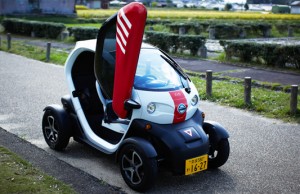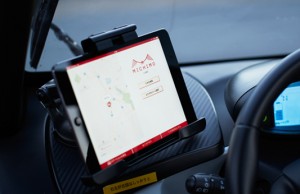“MICHIMO” A round-trip transport tool that considers the environment and characteristics of the local area
This article was produced by CLAIR Tokyo HQ, as part of a series of case studies which can be found here.
The Asuka region of Nara Prefecture, with Asuka Village at its centre, is regarded as the first capital of Japan. During the period in which Asuka was the capital, the name of the country was changed from “Wa” to “Nihon”, and the “Code governing” system was established with the Emperor at its centre. Historical accounts trace modern Japanese politics and culture back to the Asuka region, and it is therefore referred to as the origin or spiritual home of Japan. Today, a number of historic sites and elements of cultural heritage survive as they were, and about 800 thousand tourists visit annually. However, since tourist spots are scattered around a vast, mountainous area, tourists were forced in the past to make their excursions within the region using rental bicycles, public buses, or privately-owned cars.
While tourists were able to enjoy Asuka, these modes of transport created logistical issues. Rental bicycles limit the places tourists are able to visit, as some tourist destinations are geographically isolated. Public buses have limited service and routes. Additionally, narrow roads make access difficult for many vehicles including normal cars.
Concerns were raised that these circumstances were negatively impacting the satisfaction level of visitors and their intent to visit again. This was also perceived as a challenge for the further development of the area as a tourist destination.
While researching how to tackle the issue, we came upon ultra-compact vehicles which have increased in popularity in Europe. Ultra-compact vehicles are smaller and can easily make tight turns. They have a two-person capacity, consume only about one-sixth of the energy that an ordinary vehicle would use, and emit no CO2, making them environmentally friendly. For these reasons, we determined that these vehicles would be an appropriate solution to the issue, suitable for use in the Asuka region, and would help to promote tourism of the wider area, broadening the region’s appeal. We decided to proceed with their introduction.
Purpose of project
1. Offer comfortable and efficient round trips for tourists
2. Improve satisfaction level of tourists
3. Preserve local environments
4. Promote the use of low-emission vehicles
5. Introduce a new travel option
Ultra-compact vehicles called “MICHIMO” are available at Kintetsu Asuka Station, one of the gateways to sightseeing in Asuka. The name “MICHIMO” is derived from the hope that “tourists will drive these vehicles, encounter the unknown and feel physically and mentally happy”. The vehicles are permitted for use in parts of three municipalities (Asuka Village, Kashihara City and Takatori Town), allowing tourists to enjoy a wider area. Anyone who holds a driver’s licence for ordinary vehicles (including international driver’s licences) can use the vehicles for 3 hours, 5 hours, or a whole day (8 hours).
As some operations and features are slightly different from those of ordinary vehicles, a 20-minute walk through and test drive are provided before rental. In addition, the roads were examined before business commenced, in order to identify areas that are potentially dangerous. We have taken these steps to ensure the safety of users. Furthermore, in order to promote better understanding of local communities and history, and to improve travel comfort and efficiency, the vehicles are equipped with tablets that have a navigation function and an explanation of model routes and tourist spots, which serve as travel assistants. Also, the location feature of the tablet allows us to keep track of users.
Characteristics and advanced features
We took the initiative and introduced ultra-compact vehicles for tourism, which are not yet widely used in Japan. They improve traveller convenience and are environmentally friendly. Furthermore, opportunities are created for local residents to learn about and experience ultra-compact vehicles.
As ultra-compact vehicles run on electricity, we built nine charging facilities within the area in order to respond to charging demands during travel. These charging facilities have an authentication system that prohibits the charging of other vehicles. This system prevents electricity theft and enables us to monitor where, when and to what extent the vehicle’s charge.
Effects of project
After the project started, we have seen consistent use of about 1,000 vehicles every year. The round-trip transport system in the Asuka region that considers both traveller convenience and environmental friendliness has gained a certain level of recognition and contributed to the improved level of tourist satisfaction. 3 There has also been an improved awareness of tourism as well as appreciation of ultra-compact vehicles by local residents. As ultra-compact vehicles themselves are rare in Japan, they provide fresh content for sightseeing and invite a new kind of visitor.
Problems and responses
As with many travel destinations, tourism tends to be concentrated in the peak seasons of spring and autumn, and slump in summer and winter. Having no air conditioners or heaters in the vehicles also exacerbates this trend. Even if no vehicles are operated, certain costs including personnel expenses are incurred as the business operates. In order to ensure steady business even in low seasons, we are taking measures to appeal as a fun activity, diversify channels for reservations and enhance promotional activities. In the past, we also had an issue with rain being blown inside the vehicles as they had no window covers. However, we resolved this issue by purchasing simple detachable windows. MICHIMO driving on a public road
Outlook
At present, the use of MICHIMO by foreign visitors is limited to those who understand and can converse in Japanese. This is intended to address possible trouble such as traffic accidents. However, as travellers from abroad increase, we would like to establish a system that allows foreign visitors who are unable to speak Japanese to use the vehicles.
As our business model spreads to other regions, we anticipate the tourism industry in Japan will become more vibrant and attractive. Also, we have high expectations that the use of environmentally friendly ultra-compact vehicles for tourism will increase the market for them in Japan.
Reference URL https://michimo.jp
Contacts
Department in charge: General Foundation Asuka Village Regional Development Corporation Tel: +81-744-54-4577 Email: info@asukadeasobo.jp



